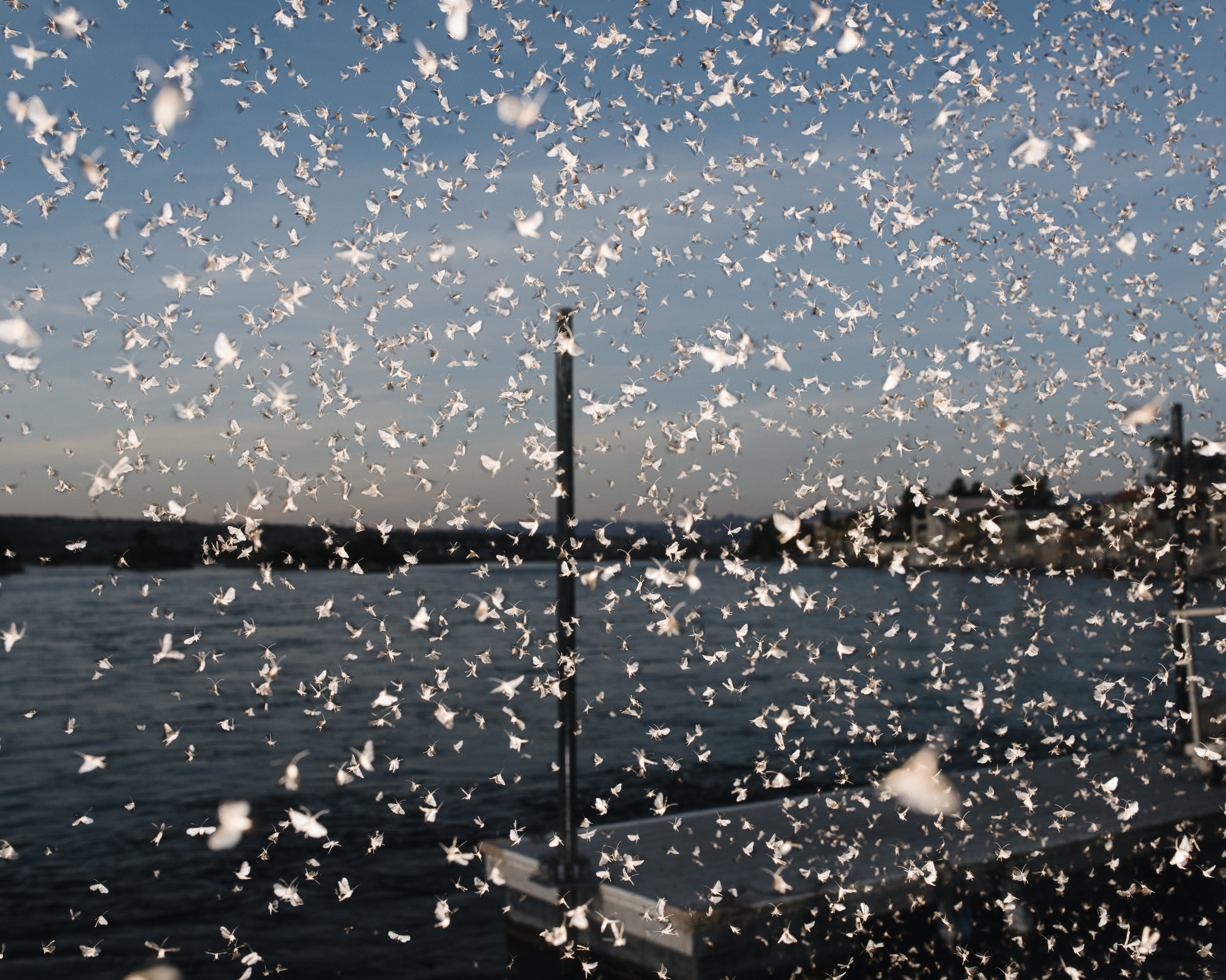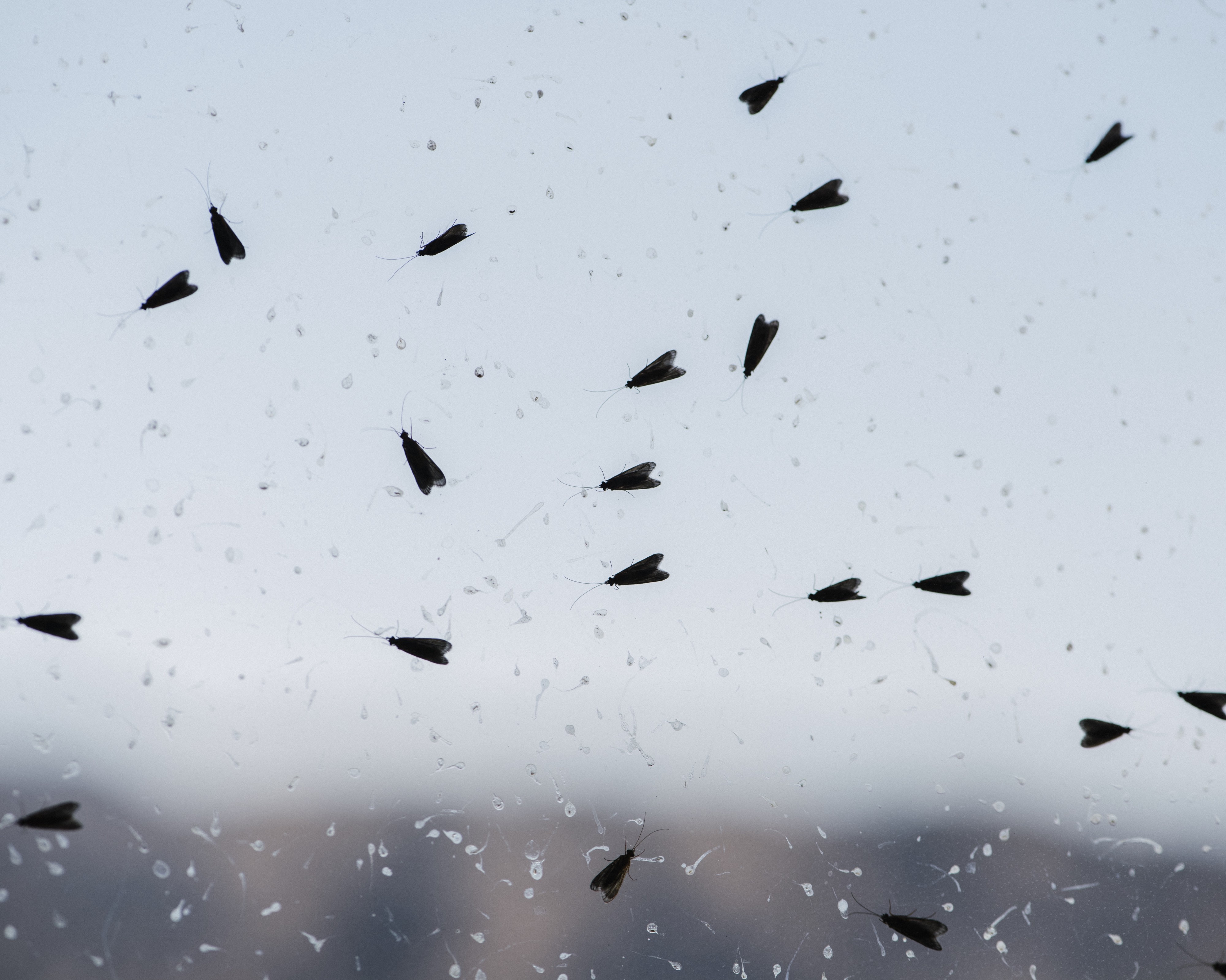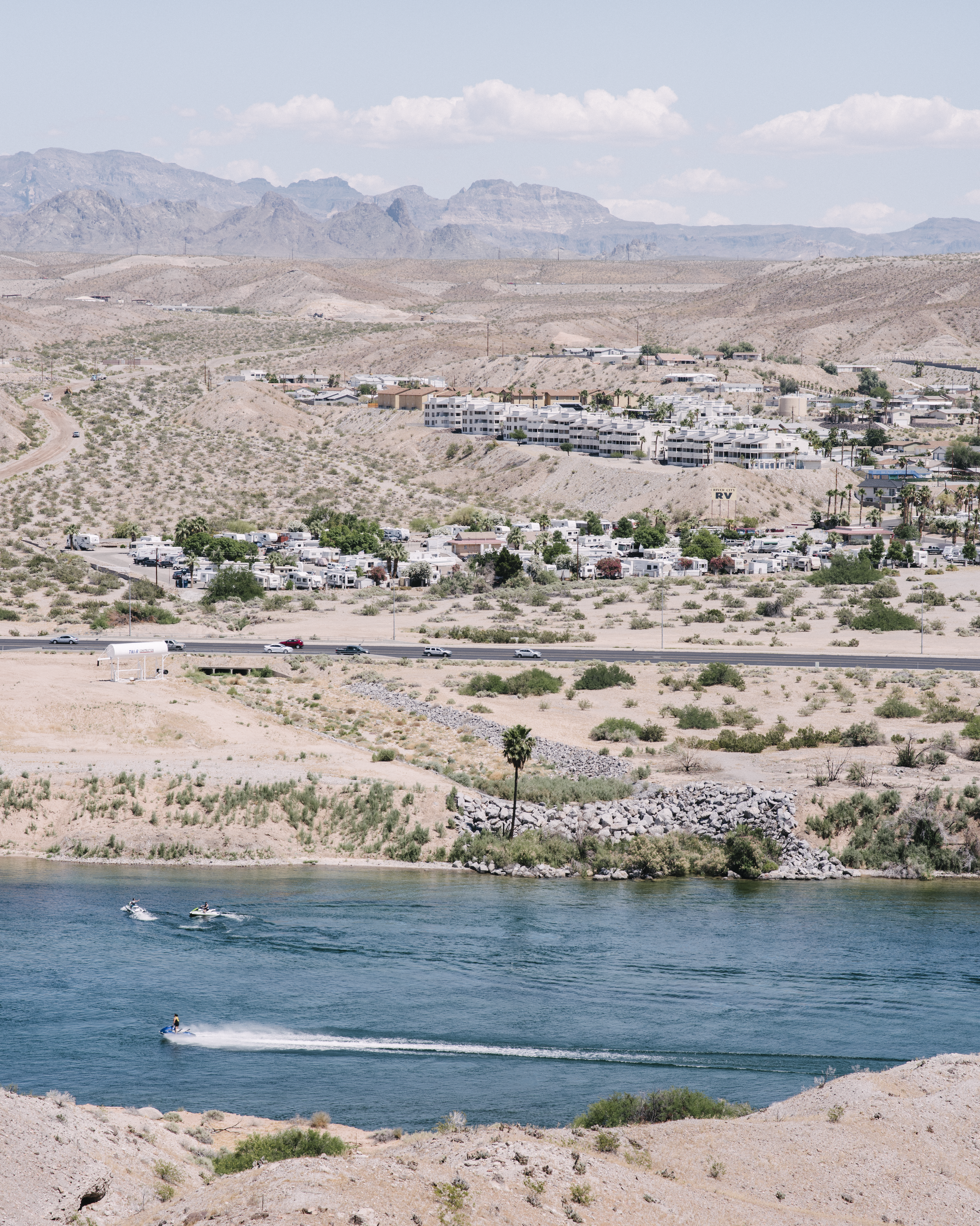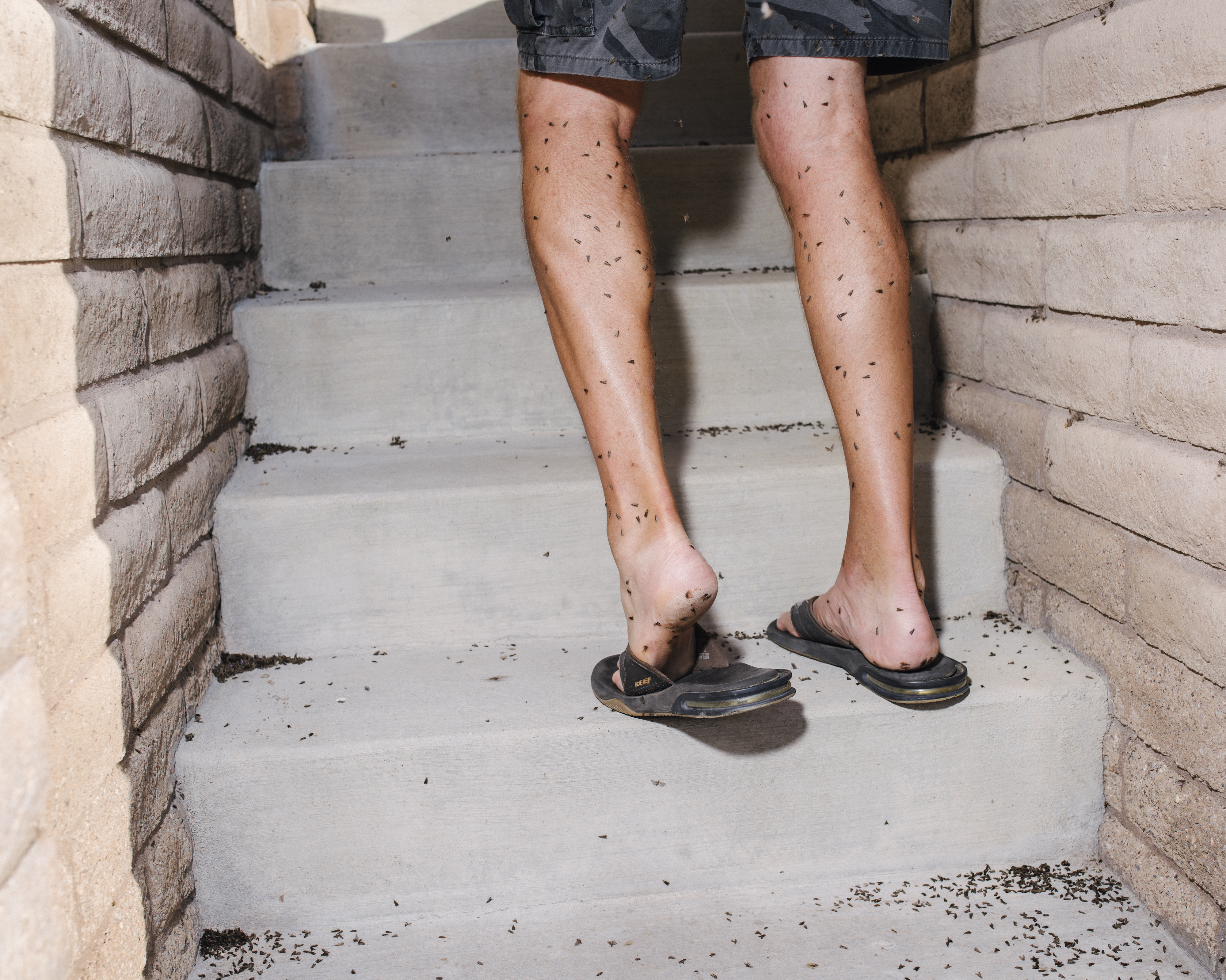 Photography: John Francis Peters
Photography: John Francis Peters
Meet the small, greasy insects upending life in an idyllic community.
 Caddisflies cluster together on a window at Denise Vallon?s home, Bullhead City, AZ.
Caddisflies cluster together on a window at Denise Vallon?s home, Bullhead City, AZ.
During the day, the insects would settle on the windows, their grimy black silhouettes marring the view like dead pixels on a television screen. When the flies took flight again, they left behind grease marks on the glass. Denise complained that the swarms were so thick she couldn?t have dinner parties outside. They?d stick to the hamburger patties coming off the grill.
Craig learned that these insect interlopers were caddisflies, a native species that thrived in places with clean, clear water. ?Caddis,? as they?re known to anglers, are an important part of the Colorado River ecosystem, serving as food for native fish. Other stretches of the waterway were actually suffering from a dearth of the aquatic insects, and local officials insisted that their abundance in Bullhead was an auspicious sign, an indication of just how healthy the lower Colorado River was. But Craig felt like he was being gaslit, that officials were refusing to acknowledge an insect run amok. ?I?m going to expose this thing,? he told Denise. He decided to run an ad on a digital billboard on Highway 95, the main drag into town, that highlighted the crisis and offered an easy solution.
WARNING!!Don?t buy property near river in Bullhead City.MOTH INFESTATIONEnjoy the Swarm ? You?ll Need a NetEASY FIX STOCK MORE TROUT IN THE RIVER
?You?re going to get your ass sued,? Denise told him. Craig paid for the first week, and then his neighbors gave him donations to keep it up for another week. ?The city was getting pissed,? Denise remembers. Craig drove around the neighborhood with a stack of flyers that he had her stick in people?s mailboxes ? at least until the post office warned them it was a federal offense.
Whatever triggered the outbreak undoubtedly had something to do with the river, where the caddisflies spend most of their lives. The 1,450-mile long Colorado River begins in the Rocky Mountains and quenches much of the thirst of the Southwest before terminating as a trickle into Mexico?s Sea of Cortez. Once a famously muddy river, it has been made crystal clear by over a dozen major dams on its main stem and many more on its tributaries ? a transformation that has upended its natural ecology.
 Denise Vallon looks out at the Colorado River behind her home, Bullhead City, AZ.
Denise Vallon looks out at the Colorado River behind her home, Bullhead City, AZ.
Wild rivers that churn and pulse and rise and fall have become a rarity. Around the world, two-thirds of the longest rivers have been dammed, creating massive man-made reservoirs and halting the flow of critical sediment downstream. Dams have obvious consequences for wildlife: They prevent fish from reaching their spawning grounds and flood former habitats. Environmentalists often decry the loss of species diversity in rivers that have been dammed. But while some species lose when we meddle with rivers, others win, sometimes in dramatic and unforeseen ways.
Craig Vallon passed away last year, but the ecological horror story unfolding in and around Bullhead shows no sign of letting up. To battle the caddisflies, local officials brought in PhD entomologists from across the country, tested out pesticides and deterrents for homeowners, and dumped hungry trout in the river, hoping they?d consume the caddisfly larvae. Now, 2019 marks four years of trying to beat back the infestation, but nothing seems to be working very well.
On TripAdvisor, you can still find reviews of the once-popular riverwalk in Laughlin, Nevada. The titles tell the story: ?Attack of the Bugs,? ?Bug City,? and ?Nice walk if you don?t mind bugs.? One reviewer wrote, ?If you?ve ever read Stephen King?s The Mist, you?ll have an idea of what this is like.?
 The Colorado River and Bullhead City, AZ from the Laughlin, NV shore.
The Colorado River and Bullhead City, AZ from the Laughlin, NV shore.
Biodiversity is not just about the sheer numbers of species in an ecosystem, but about the relative proportions of the players. Healthy ecosystems have both rare and common species, and periodic population explosions are the norm for species like rats and cockroaches with the ability to multiply quickly. But when a single species becomes overwhelmingly abundant year after year, that?s usually a sign that there?s a serious problem. ?Everybody recognizes that there are native species that are breaking out and becoming pests,? says Ruth Hufbauer, an insect ecologist at Colorado State University in Fort Collins.
Dams are one of the most dramatic ways humans have altered the landscape, transforming a free-flowing river into a series of wide, deep lakes. While these changes wipe out some species, they make life easier for others. In the tropics, dams have been linked to booms in populations of mosquitoes carrying malaria. In the Pacific Northwest, dams on the Columbia River have created the perfect island nesting sites for birds known as a Caspian terns, which have doubled in numbers since 1980 and prey on endangered salmon emerging from hatcheries.
The nightmare future of the planet is not just one without pandas and polar bears, but where once diverse ecosystems are turned into monocultures as biologically barren as an Iowa cornfield. Dams can contribute to that transformation. ?When dams go in you often get these simplified insect assemblages, where one or two species really dominates,? says Ted Kennedy, an aquatic ecologist with the U.S. Geological Survey in Flagstaff, Arizona.
Arizona?s caddisfly plague can be viewed as a warning of the threats faced by our rivers, and the communities that depend on them. ?What can we do to make them go away?? asks Albert Graves, an engineer who once tried to stop caddisflies from taking over a water canal near Phoenix. ?The answer is practically nothing.?

 Left: Bullhead City?s mayor, Tom Brady. Right: Rusty Braun shows off a vial of ?fish guts? which are said to contain Caddisfly larvae.
Left: Bullhead City?s mayor, Tom Brady. Right: Rusty Braun shows off a vial of ?fish guts? which are said to contain Caddisfly larvae. Davis Dam.
Davis Dam.
Over the course of our conversation, though, his tone took a turn. The caddisflies, Brady explained, were just the latest insect plague facing the city. Before the caddis, Bullhead saw a black fly infestation in the 1980s, the first sign that the ecosystem was out of whack. ?I honestly believed when I moved here that our town would never grow because the black fly situation was so out of control,? he said. Like caddisflies, black flies are a native species, bloodsuckers whose aquatic larvae also grow up in the river. Brady remembers residents walking their dogs with insect head nets and helplessly waving their arms in front of their face. ?The Bullhead salute,? they called it.
Black flies were finally controlled by introducing a strain of bacteria called Bacillus thuringiensis israelensis ? Bti, for short ? into the river. Bti produces a toxin that kills black fly larvae without making the water undrinkable or harming other creatures. ?That has probably been one of the greatest things for Bullhead City?s growth,? Brady says. The city has expanded from a population of 10,700 in 1980 to over 40,000 today. But the Bti toxin is useless against the caddisfly infestation, which threatens to put a damper on the city?s future growth. ?It?s a problem, and it could grow worse,? he said.
Although caddisflies don?t bite like black flies, their hairs and scales can send people into coughing and wheezing fits. Some unlucky souls have full-blown allergic responses, developing asthma, hives, and eczema. Befitting a creature that only expects to live a fortnight, their bodies are so mushy that if you try to brush them away, they?ll just smear across your skin and clothing. One angry resident told the town entomologist he had to wrap his kid up in plastic just to walk from the house to the car.
At night, the bugs are attracted to lights, and the riverfront casinos across the river in Laughlin draw them in from miles away. During the day, they hide out in the shade offered by waterfront vegetation and the alleyways between homes. Insecticides sprayed in the air don?t work well at controlling an insect that spends most of its life in the water, and you can?t just dump a poison in a river that?s headed straight for Phoenix. Some residents resort to household chemicals to kill them. ?We spray a lot of Windex,? admits Brea Chiodini, who runs a dinner cruise on the Colorado called the Celebration. Others have taken out their frustration by incinerating masses of flies around their homes using handheld blowtorches.
Before the caddisflies came to Bullhead, they started pestering a small unincorporated community below Parker Dam, 88 miles downstream. Biologists caught 3.5 million caddisflies ? about 12 pounds worth ? there on a single summer night in 1999. Another 15 years would pass before they began laying siege to the more populous city to the north.

 Denise Vallon on the shores of the Colorado River.
Denise Vallon on the shores of the Colorado River.
If there were gradual changes brewing in the ecosystem during that time, it went mostly unnoticed by Bullhead residents. In the spring of 2015, the caddisflies seemed to materialize overnight. They had been around in previous years, but never in such extraordinary numbers and never for such an extended period of time. Had there been just a single caddisfly season each year ? as occurs with more northerly species ? then life might be bearable. But Smicridea fasciatella can go through at least two generations annually on this stretch of the river, taking to the air from April to June and September to December. Sometimes those two emergences blur together into eight straight months of entomological ickiness.
As word of the infestation has spread, residents fear that home prices on the river will start dropping, and people will start moving away en masse. Then, the town will face another kind of extinction problem. ?If you?re trying to sell a home to someone on the river,? says Rusty Braun, who runs a small marina and bait shop, ?you?re gonna have to trick ?em.?

 Denise Vallon?s neighbor uses a blowtorch to kill Caddisflies on the side of his home?s river deck, Bullhead City, AZ.
Denise Vallon?s neighbor uses a blowtorch to kill Caddisflies on the side of his home?s river deck, Bullhead City, AZ.
A lot of people in Bullhead, including Craig Vallon, saw a link between the caddisflies and the partial shutdown of a federal fish hatchery in late 2013 that had stocked the river with hungry rainbow trout. When the caddisflies first became a nuisance in 2015, officials voted to spend their pest control budget buying trout from a hatchery in Colorado. Iburg, however, has found that the trout being stocked just weren?t eating that many caddisflies before they themselves got hooked by fishermen or gulped down by stripers.
A historic attempt to prevent a caddisfly outbreak in Montreal during the 1967 World?s Fair was a failure, even with the help of the now-banned pesticide DDT. To deal with an infestation in a water canal in Scottsdale, Arizona, engineers built a 12-foot-wide steel brush to scrape them off the concrete surface. But the bugs would just reattach downstream. ?Most entomologists in the world say there is nothing you can do with caddisflies,? Iburg told me. He gave residents practical advice, like using yellow lightbulbs rather than white ones to make them less attractive to caddisflies, and he launched a new research project just before his departure to see if the pheromones caddisflies use to attract mates could be used in traps.
But Iburg knows that a long-term solution to the caddisfly menace would require a more drastic measure. One possibility was periodically turning off the spigot on the dam: Let the river run dry to scorch all the bugs. It was a kind of check on the system that may have happened naturally in the past during periods of drought. But a dry river is a nonstarter: It would upend the local economy, harm endangered species, upset boaters and farmers, and, at least temporarily, ruin the views of many retirees.
 Tourists take a morning stroll along the Laughlin River Walk, Laughlin, NV.
Tourists take a morning stroll along the Laughlin River Walk, Laughlin, NV.
The U.S. Bureau of Reclamation has started experimenting with timing water releases from Glen Canyon Dam to help revive the aquatic ecosystem there. They run the river at high flow levels in the hopes of flushing more sediment into the canyon, and then they allow a few days of steady ?bug flows? to improve the survival of insect eggs. So far, it seems to be helping. But for how long?
Across the West, dam removal has been championed as a way to reverse the damage we?ve caused to river ecosystems. The writer Edward Abbey once called the Glen Canyon Dam ?an insult to God?s Creation? that will one day collapse to the delight of humans and ?to other creatures which have an equal right to the enjoyment of the earth.? For now, however, dam removal advocates have gone after dams that have long since outlived their usefulness, and far too many people depend on the dams of the Colorado River for their removal to be taken seriously.
Bullhead City, of course, wouldn?t exist were it not for Davis Dam. For the foreseeable future, its residents will have to adapt to this strange new ecosystem we?ve created ? or move away from the river. In the meantime, they?ve hired a new entomologist ? or, as the town paper called it, a new ?bug slayer? ? whose standout resume included caddisfly experience in Nebraska. He is going to need it. After I returned to my home in Los Angeles, I got an email from Denise, letting me know the bug season had arrived. ?Caddisflies are in huge swarms and landing all over the windows,? she wrote. ?It has just started but I believe it is going to be biblically epic.?

